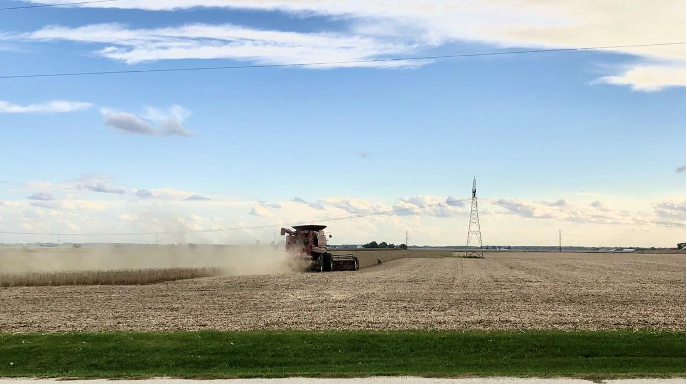If you think you or someone you love might have a soy allergy, you’re in the right place. This post covers the prevalence of soy allergy and what the current research says for both adults and children. While we will discuss the current understanding of the science, it’s always important to speak with your medical team to address your specific conditions.

Disclosure: This post is in collaboration with the Soy Nutrition Institute (SNI) Global, an organization leading the way in soy and health research and education, and the United Soybean Board. All material addressed in this post is supported by science and hyperlinked for those looking for more information. As always, thanks for reading the science that keeps my corner of the web flowing!
Table Of Contents
- What Is Soy
- Signs & Symptoms of Soy Food Allergy
- How Common Are Soy Food Allergies
- Insight From An Allergist
- Do Soy Allergies Raise Concern For Other Food Allergies
- Introducing Soy To Babies
- Where To Get More Information
If this is your first time here on Shaw Simple Swaps, welcome! I’m a registered dietitian and mom to two littles, one of which has a severe milk allergy (you can read more about that here.)
Ever since his diagnosis at 6-months old, I’ve become fascinated with the research surrounding the early introduction of potential food allergens to prevent the development of allergy later in life and the importance of looking at the evolving science. While I may be a science geek at heart, I’m also an anxious mom who understands the everyday struggles of living with a child with a food allergy.
Rest assured — I am here to present the scientific findings surrounding soy allergies and offer my practical advice on navigating food allergies.
What is Soy?
Let’s start by exploring what soy is. Soybeans are a nutrient-rich source of plant protein and are a member of the legume family, which also includes peanuts, beans, lentils, and peas. Soy provides all nine essential amino acids and contains B vitamins, fiber, and magnesium.
Soybeans are typically harvested in the fall and can be found in a variety of different foods and forms. Some of the most common soy foods are tofu, edamame, tempeh, textured vegetable protein (TVP), soymilk, soy-based yogurts and burgers. Soy is also found in condiments, such as soy sauce, miso and tamari. Soy is also found in a variety of processed forms such as soy lecithin and highly refined soybean oil. However, soybean oil can be consumed by people allergic to soy because it does not contain sufficient protein to elicit an allergic reaction. As always, speak with your physician if you have any concerns.
Fun fact, Mr.CEO actually grew up on a farm that harvested soybeans! The Shaw Family Farm is a centennial farm (meaning it has been in existence over 100 years) in the northern Illinois region. Here’s a picture of the last soybean harvest on the Shaw farm before his dad retired last year.

What Are the Signs and Symptoms of A Soy Food Allergy?
According to the American College of Allergy, Asthma, and Immunology, common signs and symptoms of a food allergy to soy include:
- Vomiting
- Stomach cramps
- Diarrhea
- Wheezing
- Shortness of breath, difficulty breathing
- Coughing
- Tightness in throat, hoarse voice
- Weak pulse
- Pale or blue coloring of the skin
- Hives
- Swelling, can affect the tongue and/or lips
Though you may recognize that you or your child may have some of these symptoms, be cautious of self-diagnosis; food intolerances and food allergies present similar signs and symptoms.
The big difference between a soy intolerance and a soy food allergy is that a true food allergy affects the immune system as a result of the body interpreting the soy protein as a “foreign invader”. The body responds by creating immunoglobulin E (IgE) antibodies that disperse throughout the body causing the allergic symptoms to develop. Food allergies can be either IgE mediated, which means the onset of symptoms occur within 1 to 2 hours or non-IgE mediated meaning the onset of symptoms occur greater than two hours after consumption or exposure and can present for a longer period of time; however, both are equally concerning.
While it’s unlikely that soy food allergies will lead to anaphylaxis (a life-threatening situation that causes restriction of the airways), it’s important to always proceed with caution and speak with your pediatrician or healthcare provider about seeing an allergist to diagnose a food allergy using the right tests.
How Common Are Soy Food Allergies
First and foremost, I want to say it again because it’s that important to remember— A true food allergy diagnosis requires repeated testing with an allergist, often concluding with an oral food challenge test. The problem though is that these tests are expensive and time intensive. Consequently, studies typically rely on self-reported data to identify food allergies. With this in mind, let’s take a look at the reported prevalence of soy food allergies in both kids and adults.
According to the Food Allergy Research and Education (FARE) organization, 32 million Americans have a food allergy, with 5.6 million of those being under the age of 18. Based on data from studies conducted in 2018 and 2019, approximately 1.9 million Americans present symptoms related to a soy food allergy.
Soy allergies have been found to be more common in infants and young children than adults. Approximately 0.4% to 1.5% of infants in the United States have a soy food allergy. However, research shows that most children diagnosed with a soy allergy will outgrow their allergy between by 10 years of age.
Keep in mind the above statistics do not necessarily account for diagnosed soy food allergies or food allergies in general. Oftentimes individuals present similar symptoms with a food intolerance as an allergy, however as noted they are quite different.
A 2020 review in Nutrition Today found that true soy food allergies are not as common as perceived. Scientists analyzed available data on food allergies in North America that had been published in the eight years prior to their review. The foods included in this review were labeled as soy, milk, egg, fish, shellfish, wheat, treenuts, and peanuts, collectively known as the “Big 8”, as well as sesame and a general category labeled “any foods”.
In the United States, data from the National Health and Nutrition Examination Survey (NHANES), Food and Drug Administration (FDA), Food Safety Surveys (FSS), and National Institute of Allergy and Infectious Disease (NIAID) Survey were used, while from Canada, the Surveying Canadians to Assess the Prevalence of Food Allergies and Attitudes Towards Food labeling and Risk Survey was used. What these researchers found was pretty fascinating.
A Closer Look at the “Big 8”
The identification of major food allergens on food labels began in 2004 when Congress passed the Food Allergen Labeling and Consumer Protection Act (FALCPA). When this passed, the data used to identify the “Big 8” was primarily based on the pediatric population, not adults, and was limited in prevalence data, especially for soy and wheat. While a large-scale study to identify food allergy prevalence would be very challenging to conduct due to the multiple features it would need to involve (i.e. like demonstrating adverse reactions to a food through the use of a food challenge test), the evolving science is important to pay attention to, especially as more foods become labeled as allergens in the United States.
Nutrition Today Review: Prevalence of Soy Food Allergy in Adults
Based upon the available surveys of people 18 years and older, researchers found the following:
- Soy protein allergy was the least prevalent food allergy among survey participants compared to seven of the other eight allergenic foods studied (sesame was the only food with a lower allergy prevalence than soy.)
- Milk/dairy and shellfish were the most prevalent food allergies.
- In the FSS study, the prevalence of pea protein allergy was similar to that of soy, despite pea not being a major allergen in the US. This may be because of lack of research, but is something to be aware of due to the number of plant-based products being made with pea protein.
Nutrition Today Review: Prevalence of Soy Food Allergy in Kids
Based on the four studies, researchers found that:
- Soy protein allergies were slightly variable depending on the study being reviewed, however across all studies soy allergies were reported less than milk/dairy allergies.
- Sesame allergies in all studies were reported less frequently than soy allergies.
- Further analysis showed the highest prevalence rate (1.5%) for soy allergy at age one with a steady decline to 0.2% for ages 14 to 17.
While the information used for this analysis was self-reported data and thus is always subject to error, it does provide information to lead additional research on food allergies.
New Research on the Horizon: The Start Eating Early Diet Initiative (SEED)
The Food Allergy Research and Education (FARE) has initiated new research, entitled SEED (The Start Eating Early Diet Initiative), in collaboration with Dr. Ruchi Gupta and her team from Northwestern University Feinberg School of Medicine and Ann & Robert H. Lurie Children’s Hospital of Chicago.
The study involves a three-year randomized controlled trial (RCT) comparing early introduction of several highly allergenic foods to the standard of care in a large and diverse sample of infants. The results of this research will be a great addition to the science and will help guide parents through the introduction of other allergenic foods, similar to the way it has been done for peanuts and eggs.
Insight From An Allergist: What They See Regarding Soy Allergies In Practice
To get the scoop on what allergists are seeing in their practice, I spoke to Dr. Kathleen Luskin, MD, an allergist and immunologist in San Diego, CA. Dr. Luskin says she has seen more IgE mediated versus non-IgE mediated reactions with soy food allergies in her practice.
While she notes there is some cross reactivity of a true soy allergy and other food allergies, most allergists often empirically exclude soy in certain non-IgE mediated reactions, making it difficult to discern the exact prevalence.
However, Dr. Luskin prefers to take a rather “aggressive approach” to early food introduction, sharing that in her opinion:
The sooner the immune system can be exposed to a food and hopefully ‘learn’ that is it something that should be tolerated, the better.
Do Soy Allergies Raise Concern for Other Food Allergies?
According to the research, being medically diagnosed with a true soy food allergy does warrant consideration of other potential food allergies. While the sample size was small, past research has shown that soy allergic individuals may be sensitized or allergic to other legumes such as peanuts, as well as other top allergens such as tree nuts, milk, egg, and sesame. However, individuals allergic to peanuts were not likely to be allergic to soy or the other legumes, such as beans, peas, and lentils.
Because food allergies are so individualized, it’s important to work directly with an allergist and medical team for your particular case. Research supports that one should never eliminate an entire food group without proper diagnosis, as that can lead to nutrient deficiencies without proper nutrient insight from an expert.
How I Safely Introduce Soy To My Milk Allergy Son
While my son has a diagnosed milk allergy, he also originally had a medically diagnosed peanut allergy, meaning he tested positive on both the skin prick and blood tests. However, as I go into more depth about here, these tests can present false positives 50% to 60% of the time.
With the help of his allergist, we moved forward with an oral food challenge. He passed the challenge, demonstrating only some mild hives, and we left with the “homework” of introducing peanut protein three times a week in two-gram doses so it could help his body outgrow the allergy.
Believe me when I say it was a little anxiety-provoking, even as a healthcare professional, but I’m so glad we proceeded with the help of our allergist (and had appropriate medication on hand should anything escalate beyond a few hives). I’m happy to say after four months of these two-gram doses, he now has no reaction to peanuts! This outcome shows why it is imperative to not eliminate an entire food group without proper diagnosis and treatment from a professional.
When he tested positive on his oral food challenge for the milk allergy, the allergist did encourage us to go home and start introducing the other more common allergens like soy and tree nuts that we had not tried yet. Thankfully, at that time, he had already tried egg as well with no reactions.
We started soy introduction with tofu cut into chunks, marinated in sesame oil, vinegar, and spices, and air fried briefly in a chickpea flour coating. Note, you can serve the tofu straight from the refrigerator after it’s been drained, but I highly encourage adding some low- to no-sodium spices, seasonings, vinegars, etc. either way; it will help open their taste buds to new flavors as well!

My son did really well with this option, and he did not experience any reaction.

We continue to incorporate soy by serving softened and age-appropriate sizes of tofu, tempeh, edamame (he loves hummus with this), and unsweetened soymilk and soy yogurt in fruit and veggie smoothies and popsicles.

What You Need To Remember
Diagnosing a true food allergy requires a team, including your primary healthcare provider, an allergist, and a registered dietitian. Work with these individuals to determine what you are truly allergic to and how to balance your nutrient needs. While soy food allergies are less prevalent than other allergenic foods, your medical team can help identify what is causing your symptoms and work with you to set up the dietary program right for you.
Where to Get More Information On The Latest Research Regarding Soy Allergy
To learn more about soy health and nutrition, visit Soy Nutrition Institute (SNI) Global: www.SNIGlobal.org. You can also follow SNI Global on Twitter, Facebook, and LinkedIn to stay up-to-date on all things soy!



Leave a Reply